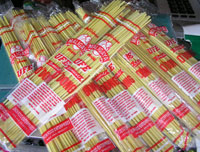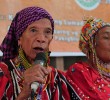Or is there such a thing as Davao cuisine?
By Germelina A. Lacorte
davaotoday.com
DAVAO CITY � Think of it as lasagna, only different. Its layers are made of beef, chicken gizzard, liver, spiced with lemon grass, ginger, onion, garlic, achuete, alugbati leaves, kesong puti (cheese), and odong, the poor man�s noodles.
Unlike lasagna, however, �haob na odong� is wrapped in banana leaves and �baked� in hot coal, like a bibingka. (Others fry it.)
�
Contrary to the popular view among visitors that Davao cuisine is limited to inihaw na panga (grilled tuna jaw) or Luz�s kinilaw (tuna salad),� there are some fare, though not yet popular, that Davao can call its own. �Haob na odong� is one such dish; it uses a Davaoe�o method of cooking, which is to wrap the ingredients with banana leaves and �bake� it by grilling, steaming or frying.
 Paddy Lascano, a Davaoe�o chef at the Unilever Food Solutions, said he used to be skeptical about the existence of a Davao cuisine — until he did a research among Mindanao�s indigenous tribes a few years back and discovered something that is distinct from the rest of the country.
Paddy Lascano, a Davaoe�o chef at the Unilever Food Solutions, said he used to be skeptical about the existence of a Davao cuisine — until he did a research among Mindanao�s indigenous tribes a few years back and discovered something that is distinct from the rest of the country.
Unlike the cuisine of Luzon and the Visayas, cooking a la Davao does not use much oil and not much saut�ing. �Davaoenos almost use the same spices (as those in the Visayas and Luzon) but you�ll be amazed!� Lascano said. �Cooking here preserves and enhances the natural flavor of meat and fish.�
Odong, for instance, which is considered the poor man�s noodles, has a heritage that goes back to the arrival of the Japanese here (�udon� is a Japanese noodle). Japanese workers, some of whom had helped build the Kennon Road in Baguio city, migrated to Davao at the turn of the century to work in the city�s abaca (hemp) plantations.
�In a sense, odong is part of our Japanese heritage,� said Lascano. At some point in its history, Davao teemed with Japanese shops and restaurants and was used to be known as �Little Tokyo.�
While Visayas cooking, which is strongly influenced by Spain, rely more on pepper and garlic for spices, Davao�s indigenous tribes rely more on herbs and land crops.
Indigenous Davao cooking also uses ingredients readily available and which are mostly grown here, among them, langkawa (yellow ginger) and duwaw (turmeric), kalabo (local variety of oregano) and onions, which thrive in Davao Oriental.
The Visayans and the folk in Luzon saut� a lot but among Davao�s indigenous tribes, �they don�t saut� the spices, which account for the distinct taste and flavors,� said Lascano, who did his research among the Mandayas, Bagobos, the Samalnons, Tausugs, the Maranaos and the B�laans in the 1990s.
For example, another recipe, �Manok Kiarian,� has the same combination of herbs — ginger, onion and lemon grass — that Visayans would often use. But cooked in slow fire with just a small amount of water, and without oil, it gives off a totally distinct taste.
Another recipe, which Lascano calls �Kula-sog,� is also done this way: beef or carabao meat is mixed in a pot with a minimum amount of water and cooked slowly, until tender, in tabliya (chocolate), pineapple, onions, lemon grass, turmeric, and hot chili.
�Saut�ing changes the taste of the food,� Lascano explained. It enhances, he said, the spiciness and fragrance of the dish. �The taste of toasted ginger is different from those cooked in water. Saut�ing heightens the food�s spiciness and fragrance but the real taste and flavor of beef is preserved when cooked with herbs in a little water,� he said. �This is Davao cuisine.�
Lascano, who also specializes in other Asian cuisine, said he had tried comparing the taste of Davao with other Asian tastes and flavors and discovered nothing quite like it. �Although Davao�s cooking method has been enriched by influences from Japan, Spain and the coming in of migrants from Visayas and Luzon, Davao�s indigenous tribes have developed their own unique style of preparing food that is not found in other parts of the country.
Their cooking style also rely mostly on boiling, broiling, grilling and their own version of baking, wrapping food with thick leaves and putting them over live coals. �That�s what you call steam baking,� Lascano explained.
He said an �island cuisine competition� at SM City Davao on April 27 will serve to heighten the people�s awareness of this distinctive cuisine.� �The food that we eat these days is no longer done the way Davao used to do it,� he said. �Our goal is to encourage more restaurants and eateries to use basic Davao food ingredients and to pay more attention to Davao cuisine.� (Germelina A. Lacorte/davaotoday.com)
Food









